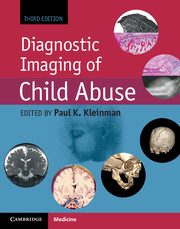Book contents
- Frontmatter
- Dedication
- Contents
- List of Contributors
- Editor’s note on the Foreword to the third edition
- Foreword to the third edition
- Foreword to the second edition
- Foreword to the first edition
- Preface
- Acknowledgments
- List of acronyms
- Introduction
- Section I Skeletal trauma
- Chapter 1 The skeleton: structure, growth and development, and basis of skeletal injury
- Chapter 2 Skeletal trauma: general considerations
- Chapter 3 Lower extremity trauma
- Chapter 4 Upper extremity trauma
- Chapter 5 Bony thoracic trauma
- Chapter 6 Dating fractures
- Chapter 7 Differential diagnosis I: diseases, dysplasias, and syndromes
- Chapter 8 Differential diagnosis II: disorders of calcium and phosphorus metabolism
- Chapter 9 Differential diagnosis III: osteogenesis imperfecta
- Chapter 10 Differential diagnosis IV: accidental trauma
- Chapter 11 Differential diagnosis V: obstetric trauma
- Chapter 12 Differential diagnosis VI: normal variants
- Chapter 13 Evidence-based radiology and child abuse
- Chapter 14 Skeletal imaging strategies
- Chapter 15 Postmortem skeletal imaging
- Section II Abusive head and spinal trauma
- Section III Visceral trauma and miscellaneous abuse and neglect
- Section IV Diagnostic imaging of abuse in societal context
- Section V Technical considerations and dosimetry
- Index
- References
Chapter 2 - Skeletal trauma: general considerations
from Section I - Skeletal trauma
Published online by Cambridge University Press: 05 September 2015
- Frontmatter
- Dedication
- Contents
- List of Contributors
- Editor’s note on the Foreword to the third edition
- Foreword to the third edition
- Foreword to the second edition
- Foreword to the first edition
- Preface
- Acknowledgments
- List of acronyms
- Introduction
- Section I Skeletal trauma
- Chapter 1 The skeleton: structure, growth and development, and basis of skeletal injury
- Chapter 2 Skeletal trauma: general considerations
- Chapter 3 Lower extremity trauma
- Chapter 4 Upper extremity trauma
- Chapter 5 Bony thoracic trauma
- Chapter 6 Dating fractures
- Chapter 7 Differential diagnosis I: diseases, dysplasias, and syndromes
- Chapter 8 Differential diagnosis II: disorders of calcium and phosphorus metabolism
- Chapter 9 Differential diagnosis III: osteogenesis imperfecta
- Chapter 10 Differential diagnosis IV: accidental trauma
- Chapter 11 Differential diagnosis V: obstetric trauma
- Chapter 12 Differential diagnosis VI: normal variants
- Chapter 13 Evidence-based radiology and child abuse
- Chapter 14 Skeletal imaging strategies
- Chapter 15 Postmortem skeletal imaging
- Section II Abusive head and spinal trauma
- Section III Visceral trauma and miscellaneous abuse and neglect
- Section IV Diagnostic imaging of abuse in societal context
- Section V Technical considerations and dosimetry
- Index
- References
Summary
Introduction
Fractures are common injuries in abused children, second only to cutaneous bruising (1). Although fundamental to the documentation of abuse, the fractures are rarely life-threatening and few result in long-term deformity. Specific types of fractures are known to be associated with abuse, and their recognition is important for their accurate identification and in understanding their significance.
Many reports of unexplained subdural hematomas (SDHs) in infants had appeared before Caffey’s historic 1946 article, but it was only after he associated these lesions with certain patterns of skeletal injury that the modern medical entity of child abuse was formulated (2). In a sense, recognition of the role of skeletal injuries in child abuse became the catalyst for the surge of interest in child maltreatment after Caffey’s original description.
In the years that followed, most reports of child abuse focused mainly on the radiologic alterations associated with the skeletal trauma (3–14). The confident documentation of skeletal injury, facilitated by characteristic radiologic alterations, provided investigators the opportunity to study the multiple facets of child abuse. Eventually, the blend of the clinical and the radiologic findings led Kempe, Silverman, and others to bring these associations to the status of the “battered child syndrome” (15).
- Type
- Chapter
- Information
- Diagnostic Imaging of Child Abuse , pp. 23 - 52Publisher: Cambridge University PressPrint publication year: 2015
References
- 10
- Cited by



